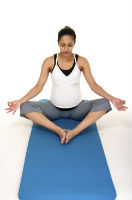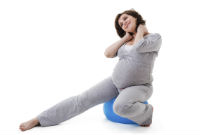3 Relaxation Techniques for Labor
To practice relaxation techniques for labor with your partner, you need to be very comfortable. Collect a bunch of pillows and teach your partner where you like them.
 Do these exercises in various positions: standing and leaning against your partner, a wall or a piece of furniture, sitting down, lying on your side and even on all-fours.
Do these exercises in various positions: standing and leaning against your partner, a wall or a piece of furniture, sitting down, lying on your side and even on all-fours.
1. Tense, and then Relax Muscle Groups
Check your whole body for muscle tension: a furrowed forehead, clenched fists and a tight mouth are the easiest ones to spot. Then practice releasing each group of muscles from head to toe systematically.
Tense, and then relax each muscle group to help you identify the two different states. When your partner cues you with “contraction,” think, “relax and release.” Then feel these tight muscles loosen.
2. Practice Touch Relaxation
This conditions you to expect pleasure rather than pain to follow tension. Find out which touches and what kind of massage relax you best. Do the same head to toe progression as above. Tense each muscle group, and then have your partner apply a warm, relaxed touch to that area as your cue to release the tension.
This means you don’t have to keep hearing the verbal cue “relax,” which eventually becomes irritating. Another goal is to be able to relax a tense muscle when your partner puts just the right touch on that spot before it begins to hurt. Practice; “I hurt here – you press hard (or stroke or touch here). ”
3. Use Visualization to Relax
A clear mind filled with soothing scenes is one of the best relaxation techniques for labor – at least between contractions. It also encourages the production of labor-enhancing endorphins that can help your labor progress.
Sports psychologists use mental imagery or visualization to help athletes perform. Follow these steps to use visualization relaxation techniques for labor:
- Determine the thoughts and scenes you find most relaxing and practice meditating on them frequently throughout the day, especially in the final month of pregnancy. You may find the following scenes helpful: rolling waves, waterfalls, meandering streams, walking along the beach with your mate.
- Think about appropriate images for use as relaxation techniques for labor. When a contraction begins, picture your uterus “hugging” your baby and pulling itself up over his or her adorable little head. During the dilating stage, imagine your cervix getting thinner and more open with each contraction.
- Change scenes from painful to pleasant. Grab the pain as if it were a big glob of modeling clay, massage it into a tiny ball, wrap it up, put it in a helium balloon, and imagine it leaving your body and floating up into the sky.
- Between and during the more painful contractions, imagine the prize rather than the pain you have to go through to get it. Picture yourself reaching down as your baby comes out, assisting your birth attendant in placing your baby on your abdomen and nestling your child against your breasts.
6 Tips on Preparing for Labor with the Right Tools
Labor is never an easy experience, but there are certain methods you can try to help make your labor go smoother. Try these 6 tips when you are preparing for labor.
1. Bring Music to Birth By
Studies show that mothers using music during labor required fewer pain-relieving drugs than mothers who did not listen to music, because music stimulates a mother’s body to release endorphins, the natural pain-relieving and relaxing hormones. Make a playlist of already-tested favorites when preparing for labor, taking care to choose songs whose rhythms relax rather than rev up your system.
2. Sit on a Birth Ball
This is a 28-inch physiotherapy ball, which naturally relaxes the pelvic muscles when you sit on it.
3. Try a Beanbag Chair
When you shop, try out various beanbag chairs until you find a squishy nest that you can imagine yourself sinking into during early labor. (Never put a baby in a beanbag chair.)
4. Bring Along Pillows and Foam Wedges
You will need at least four pillows at the hospital. Thick, tapered foam wedges, available as leftovers at upholstery shops, make relaxing back supports for sitting; a thinner one can be used as a cushion between the bed and your abdomen when side-lying.
5. Try Hot and Cold Packs
Hot packs improve blood flow to tissues; cold packs lessen pain perception in these tissues. You will need both kinds. A hot water bottle or a rubber surgical glove filled with warm water is a fine hot-pack to nestle against your lower abdomen, groin, or thigh to relieve achy muscles, or just to relax you. Packs of frozen veggies, covered with a cloth, work well as cold packs to soothe a hot forehead or numb an aching back.
6. Preparing for Labor with Different Combinations
Be sure to experiment with your bag of tricks at home to see what you think will work. Once you’re in labor, try all sorts of combinations – cold pack, counter pressure, all-fours position; side-lying, hot pack and massage; cold pack here, hot pack there, support with a wedge. You never know what will work until you try it.


